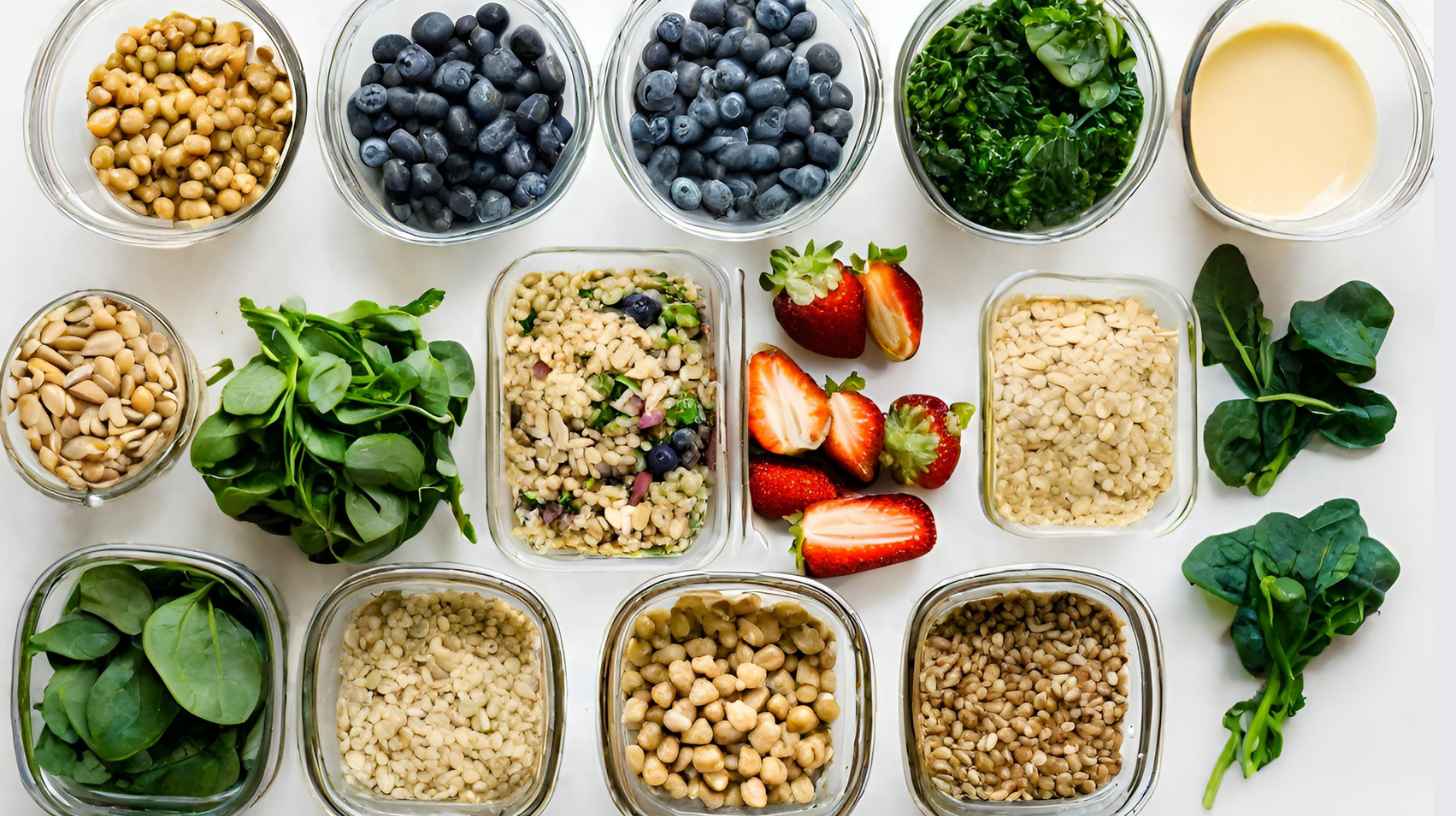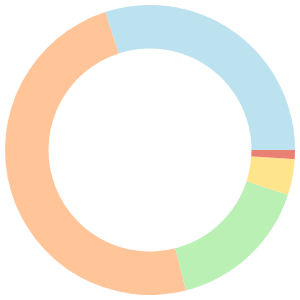Vegan meal plan for acid reflux
Address acid reflux with our 14-day vegan meal plan designed to soothe your digestive system. Featuring acid reflux-friendly recipes, this plan offers a variety of tasty options that help minimize discomfort on a vegan diet. Enjoy flavorful vegan meals that contribute to better digestive health and well-being.




Meal plan grocery list
- Oats
- Quinoa
- Brown rice
- Lentils
- Chickpeas
- Tofu
- Almonds
- Chia seeds
- Flaxseeds
- Spinach
- Kale
- Broccoli
- Avocado
- Blueberries
- Strawberries
- Bananas
- Cantaloupe
- Honeydew
- Ginger
- Unsweetened aloe vera juice
- Cucumber
- Water

Article Reviewed
Meal plan overview
Address acid reflux with our 14-day vegan meal plan designed to soothe your digestive system. Featuring acid reflux-friendly vegan recipes, this plan offers a variety of tasty options that help minimize discomfort. Enjoy flavorful vegan meals that contribute to better digestive health and overall well-being.

Foods to eat
- Quinoa and Black Bean Salad: Enjoy a protein-packed salad with quinoa, black beans, corn, avocado, and a zesty lime dressing.
- Vegan Protein Smoothie: Blend together a smoothie with plant-based protein powder, mixed berries, banana, spinach, and almond milk for a nutritious snack.
- Chickpea Pasta with Pesto: Cook chickpea pasta and toss it with homemade vegan pesto, cherry tomatoes, and pine nuts for a satisfying meal.
- Roasted Vegetable Wrap: Fill whole-grain wraps with roasted vegetables, hummus, and a sprinkle of nutritional yeast for a delicious and portable option.
- Sweet Potato and Lentil Curry: Prepare a hearty curry with sweet potatoes, lentils, coconut milk, and aromatic spices served over brown rice.
- Chia Seed Pudding: Make a chia seed pudding with almond milk and top it with fresh berries, nuts, and seeds for a nutritious dessert or snack.
- Avocado and Black Bean Quesadillas: Create quesadillas with mashed avocado, black beans, corn, and vegan cheese on whole-grain tortillas.
- Vegan Protein Bowl: Assemble a protein-rich bowl with quinoa, edamame, roasted tofu, broccoli, and a tahini dressing for a satisfying meal.
- Energy-Boosting Trail Mix: Mix together a variety of nuts, seeds, dried fruits, and dark chocolate for a nutrient-dense snack on the go.
- Vegan Stuffed Bell Peppers: Fill bell peppers with a mix of brown rice, black beans, corn, and salsa for a flavorful and energy-boosting dinner.
✅ Tip
Avoid trigger foods like spicy foods, citrus fruits, and tomato-based products, and instead focus on eating smaller, more frequent meals and incorporating soothing foods like oatmeal, bananas, and ginger.
Foods not to eat
- Highly Acidic Foods: Limit the intake of highly acidic foods such as citrus fruits, tomatoes, and spicy dishes to help manage acid reflux.
- Fried and Fatty Foods: Avoid fried and fatty foods, as they can contribute to relaxation of the lower esophageal sphincter, worsening acid reflux symptoms.
- Caffeine and Carbonated Drinks: Minimize or eliminate caffeine and carbonated beverages, which can increase stomach acid production and aggravate acid reflux.
- Chocolate and Mint: Steer clear of chocolate and mint, as they can relax the lower esophageal sphincter and potentially trigger acid reflux.
- Spicy Foods: Reduce the consumption of spicy foods, as they may irritate the esophagus and exacerbate acid reflux symptoms.
- Onions and Garlic: Limit the use of onions and garlic, as they can contribute to acid reflux symptoms in some individuals.
- Alcohol and Tobacco: Avoid alcohol and tobacco, as they can relax the lower esophageal sphincter and worsen acid reflux symptoms.
- Large Meals Before Swimming: Refrain from consuming large meals close to swimming sessions to minimize the risk of acid reflux during physical activity.
- Acidic or Carbonated Beverages During Swimming: Avoid acidic or carbonated beverages before swimming to prevent discomfort during your swim.
- Highly Processed Snacks: Choose whole, minimally processed snacks to provide sustained energy without exacerbating acid reflux symptoms.
Main benefits
The Vegan meal plan for acid reflux avoids trigger foods and includes meals that are gentle on the stomach, helping to manage symptoms and promote digestive health.

Fat
Carbs
Protein
Fiber
Other
How to budget on this meal plan
Oats and quinoa are gentle on the stomach and can be bought in bulk. Lentils and chickpeas are affordable and versatile protein sources. Almonds and chia seeds, purchased in larger quantities, are cost-effective. Berries and bananas are gentle on the stomach and can be bought frozen for better prices. Ginger and aloe vera juice are natural remedies for acid reflux and can be included in the diet.
Download the grocery list FREE
- Add & remove items
- Sort items by store aisles
- Share the list with others

Extra tips ✨
Any healthy snack ideas?
Acid reflux-friendly vegan snacks that are gentle on the stomach:
- Oatmeal with ripe bananas and almond milk
- Baked pear with cinnamon
- Steamed carrots and green beans
- Baked potato with a drizzle of olive oil
- Watermelon and cucumber salad
- Toast with mashed avocado
- Rice cakes with almond butter
What should I drink on this meal plan?
Those on a vegan diet for acid reflux can enjoy soothing beverages like aloe vera juice to calm the stomach, an almond milk smoothie, a warm herbal tea like fennel or chamomile, non-citrus infused water, and decaffeinated green tea for its anti-inflammatory properties.
How to get even more nutrients?
For those dealing with acid reflux, a vegan diet can be tailored to avoid common triggers. Focus on non-citrus fruits, vegetables that are not too acidic, and whole grains. Alkaline plant proteins like tofu and tempeh are preferable. Avoiding spicy foods, chocolate, caffeine, and fried foods can also help manage symptoms, while still maintaining a healthy and balanced vegan diet.
Meal plan suggestions
Vegan Meal Plan for Acid Reflux
This vegan meal plan focuses on foods that are gentle on the digestive system and may help alleviate symptoms of acid reflux.
Day 1
- Breakfast: Oatmeal topped with sliced bananas and ground flaxseeds
- Lunch: Quinoa salad with chickpeas, spinach, cucumber, and a lemon-tahini dressing
- Dinner: Tofu stir-fry with broccoli, kale, and brown rice
Calories: 2000 Fat: 70g Carbs: 250g Protein: 80g
Day 2
- Breakfast: Smoothie made with spinach, kale, berries, chia seeds, and almond milk
- Lunch: Lentil soup with carrots, celery, and whole-grain bread
- Dinner: Baked tofu with roasted sweet potatoes and steamed green beans
Calories: 1950 Fat: 65g Carbs: 245g Protein: 78g
Day 3
- Breakfast: Avocado toast on whole-grain bread with sliced tomatoes
- Lunch: Brown rice bowl with tofu, mixed vegetables, and a ginger-tamari sauce
- Dinner: Chickpea curry with quinoa and steamed spinach
Calories: 2050 Fat: 75g Carbs: 255g Protein: 82g
Day 4
- Breakfast: Chia seed pudding made with almond milk and topped with sliced strawberries
- Lunch: Spinach salad with avocado, almonds, and a balsamic vinaigrette
- Dinner: Stir-fried tempeh with broccoli, bell peppers, and brown rice
Calories: 2000 Fat: 70g Carbs: 250g Protein: 80g
Day 5
- Breakfast: Melon salad with cantaloupe, honeydew, and mint
- Lunch: Quinoa and black bean salad with cucumber, tomatoes, and a lime-cilantro dressing
- Dinner: Stuffed bell peppers with lentils, quinoa, and spinach filling
Calories: 1950 Fat: 65g Carbs: 245g Protein: 78g
These values are approximate and can vary slightly based on specific portion sizes and preparation methods.
Download the FREE grocery list for this meal plan
Get grocery list
Want to learn more?
⚠️ Keep in Mind
As with any dietary change, it is recommended to consult with a healthcare professional or registered dietitian before changing your dietary habits.




